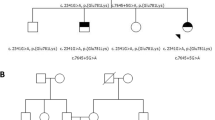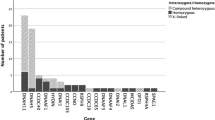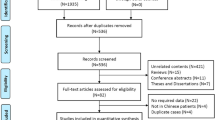Abstract
Primary ciliary dyskinesia (PCD) is an inherited disease related to ciliary dysfunction, with heterogeneity in clinical presentation and in ciliary ultrastructural defect. Our study intended to determine if there are phenotypic differences in patients with PCD based on ciliary ultrastructural abnormality. In this retrospective study carried out among 60 children with a definitive diagnosis of PCD, we analyzed clinical, radiological, and functional features at diagnosis and at last recorded visit, according to cilia defect (absence of dynein arms: DAD group, n = 36; abnormalities of the central complex: CCA group, n = 24). Onset of respiratory symptoms occurred later in the CCA than in the DAD group (9.5 versus 0.5 months, p = 0.03). Situs inversus was only observed in the DAD group, while respiratory disease in siblings were more frequent in the CCA group (p = 0.003). At diagnosis, clinical presentation was more severe in the CCA group: frequency of respiratory tract infections (p = 0.008), rhinosinusitis (p = 0.02), otitis complications (p = 0.0001), bilateral bronchiectasis (p = 0.04), and number of hypoxemic patients (p = 0.03). Pulmonary function remained stable in both groups, but outcome was better in the CCA than in the DAD group: less antibiotic therapy and hypoxemic patients (p = 0.004). In conclusion, our results underlined the relationship between the severity of clinical presentation and the ultrastructural ciliary defect.


Similar content being viewed by others
References
Afzelius BA (1976) A human syndrome caused by immotile cilia. Science 193:317–9
Barbato A, Frischer T, Kuehni CE, Snijders D, Azevedo I, Baktai G, Bartoloni L, Eber E, Escribano A, Haarman E, Hesselmar B, Hogg C, Jorissen M, Lucas J, Nielsen KG, O’Callaghan C, Omran H, Pohunek P, Strippoli MP, Bush A (2009) Primary ciliary dyskinesia: a consensus statement on diagnostic and treatment approaches in children. Eur Respir J 34:1264–76
Barlocco EG, Valletta EA, Canciani M, Lungarella G, Gardi C, De Santi MM, Mastella G (1991) Ultrastructural ciliary defects in children with recurrent infections of the lower respiratory tract. Pediatr Pulmonol 10:11–7
Bergmann C (2012) Educational paper: ciliopathies. Eur J Pediatr 171(9):1285–1300
Boon M, Jorissen M, Proesmans M, De Boeck K (2013) Primary ciliary dyskinesia, an orphan disease. Eur J Pediatr 172(2):151–162
Bush A, Chodhari R, Collins N, Copeland F, Hall P, Harcourt J, Hariri M, Hogg C, Lucas J, Mitchison HM, O’Callaghan C, Phillips G (2007) Primary ciliary dyskinesia: current state of the art. Arch Dis Child 92:1136–40
Bush A, Cole P, Hariri M, Mackay I, Phillips G, O’Callaghan C, Wilson R, Warner JO (1998) Primary ciliary dyskinesia: diagnosis and standards of care. Eur Respir J 12:982–8
Castleman VH, Romio L, Chodhari R, Hirst RA, de Castro SC, Parker KA, Ybot-Gonzalez P, Emes RD, Wilson SW, Wallis C, Johnson CA, Herrera RJ, Rutman A, Dixon M, Shoemark A, Bush A, Hogg C, Gardiner RM, Reish O, Greene ND, O’Callaghan C, Purton S, Chung EM, Mitchison HM (2009) Mutations in radial spoke head protein genes RSPH9 and RSPH4A cause primary ciliary dyskinesia with central-microtubular-pair abnormalities. Am J Hum Genet 84(2):197–209
Chapelin C, Coste A, Reinert P, Boucherat M, Millepied MC, Poron F, Escudier E (1997) Incidence of primary ciliary dyskinesia in children with recurrent respiratory diseases. Ann Otol Rhinol Laryngol 106:854–8
Chilvers MA, Rutman A, O’Callaghan C (2003) Functional analysis of cilia and ciliated epithelial ultrastructure in healthy children and young adults. Thorax 58:333–8
Chilvers MA, Rutman A, O’Callaghan C (2003) Ciliary beat pattern is associated with specific ultrastructural defects in primary ciliary dyskinesia. J Allergy Clin Immunol 112:518–24
Coren ME, Meeks M, Morrison I, Buchdahl RM, Bush A (2002) Primary ciliary dyskinesia: age at diagnosis and symptom history. Acta Paediatr 91:667–9
Corkey CW, Levison H, Turner JA (1981) The immotile cilia syndrome. A longitudinal survey. Am Rev Respir Dis 124(5):544–548
De Iongh RU, Rutland J (1995) Ciliary defects in healthy subjects, bronchiectasis, and primary ciliary dyskinesia. Am J Respir Crit Care Med 151:1559–67
El Zein L, Omran H, Bouvagnet P (2003) Lateralization defects and ciliary dyskinesia: lessons from algae. Trends Genet 19:162–7
Ellerman A, Bisgaard H (1997) Longitudinal study of lung function in a cohort of primary ciliary dyskinesia. Eur Respir J 10:2376–9
Escalier D, Jouannet P, David G (1982) Abnormalities of the ciliary axonemal complex in children: an ultrastructural and cinetic study in a series of 34 cases. Biol Cell 44:271–282
Escudier E, Couprie M, Duriez B, Roudot-Thoraval F, Millepied MC, Pruliere-Escabasse V, Labatte L, Coste A (2002) Computer-assisted analysis helps detect inner dynein arm abnormalities. Am J Respir Crit Care Med 166:1257–62
Gaultier C, Boulé M, Allaire Y, Clément A, Buvry A, Girard F (1979) Determination of capillary oxygen tension in infants and children: assessment of methodology and normal values during growth. Bull Eur Physiopathol Respir 14(3):287–297
Hellinckx J, Demedts M, De Boeck K (1998) Primary ciliary dyskinesia: evolution of pulmonary function. Eur J Pediatr 157:422–6
Huang B, Piperno G, Luck DJ (1979) Paralyzed flagella mutants of Chlamydomonas reinhardtii. Defective for axonemal doublet microtubule arms. J Biol Chem 254(8):3091–3099
Jain K, Padley SP, Goldstraw EJ, Kidd SJ, Hogg C, Biggart E, Bush A (2007) Primary ciliary dyskinesia in the paediatric population: range and severity of radiological findings in a cohort of patients receiving tertiary care. Clin Radiol 62:986–93
Kuehni CE, Frischer T, Strippoli M-PF, Maurer E, Bush A, Nielsen KG, Escribano A, Lucas JS, Yiallouros P, Omran H, Eber E, O’Callaghan C, Snijders D, Barbato A (2010) Factors influencing age at diagnosis of primary ciliary dyskinesia in European children. Eur Respir J 36(6):1248–1258
Marthin JK, Petersen N, Skovgaard LT, Nielsen KG (2010) Lung function in patients with primary ciliary dyskinesia. A cross sectional and three-decade longitudinal study. Am J Respir Crit Care Med 181(11):1262–1268
Miller MR, Hankinson J, Brusasco V, Burgos F, Casaburi R, Coates A, Crapo R, Enright P, van der Grinten CP, Gustafsson P, Jensen R, Johnson DC, MacIntyre N, McKay R, Navajas D, Pedersen OF, Pellegrino R, Viegi G, Wanger J (2005) Standardisation of spirometry. Eur Respir J 26(2):319–338
Min YG, Shin JS, Choi SH, Chi JG, Yoon CJ (1995) Primary ciliary dyskinesia: ultrastructural defects and clinical features. Rhinology 33:189–93
Noone PG, Leigh MW, Sannuti A, Minnix SL, Carson JL, Hazucha M, Zariwala MA, Knowles MR (2004) Primary ciliary dyskinesia: diagnostic and phenotypic features. Am J Respir Crit Care Med 169:459–67
O’Callaghan C, Rutman A, Williams GM, Hirst RA (2011) Inner dynein arm defects causing primary ciliary dyskinesia: repeat testing required. Eur Respir J 38(3):603–607
Papon JF, Coste A, Roudot-Thoraval F, Boucherat M, Roger G, Tamalet A, Vojtek AM, Amselem S, Escudier E (2010) A 20-year experience of electron microscopy in the diagnosis of primary ciliary dyskinesia. Eur Respir J 35(5):1057–1063
Stannard WA, Chilvers MA, Rutman AR, Williams CD, O’Callaghan C (2010) Diagnostic testing of patients suspected of primary ciliary dyskinesia. Am J Respir Crit Care Med 181:307–14
Stannard W, Rutman A, Wallis C, O’Callaghan C (2004) Central microtubular agenesis causing primary ciliary dyskinesia. Am J Respir Crit Care Med 169:634–7
Sturgess JM, Chao J, Turner JA (1980) Transposition of ciliary microtubules: another cause of impaired ciliary motility. N Engl J Med 303:318–22
Tamalet A, Clement A, Roudot-Thoraval F, Desmarquest P, Roger G, Boule M, Millepied MC, Baculard TA, Escudier E (2001) Abnormal central complex is a marker of severity in the presence of partial ciliary defect. Pediatrics 108:E86
Verra F, Fleury-Feith J, Boucherat M, Pinchon MC, Bignon J, Escudier E (1993) Do nasal ciliary changes reflect bronchial changes? An ultrastructural study. Am Rev Respir Dis 147(4):908–913
Wodehouse T, Kharitonov SA, Mackay IS, Barnes PJ, Wilson R, Cole PJ (2003) Nasal nitric oxide measurements for the screening of primary ciliary dyskinesia. Eur Respir J 21:43–7
Zapletal A, Samánek M, Paul T (1987) Lung function in children and adolescents: methods, reference values. Karger, Basel, pp 10–45
Ziętkiewicz E, Bukowy-Bieryłło Z, Voelkel K, Klimek B, Dmeńska H, Pogorzelski A, Sulikowska-Rowińska A, Rutkiewicz E, Witt M (2012) Mutations in radial spoke head genes and ultrastructural cilia defects in East-European cohort of primary ciliary dyskinesia patients. PLoS One 7(3):e33667
Acknowledgments
The authors are grateful to the children and their families who participated in this study and thank all referring physicians. This work was supported by grants from the Legs Poix from the Chancellerie des Universités, the Assistance Publique-Hôpitaux de Paris (PHRC AOM06053, P060245), the Milena Carvajal ProKartagener Foundation, and the Fondation pour la Recherche Médicale (DEQ20120323689).
Conflict of interest
All of the authors are aware and agree to the content of the paper and approve its submission. None of the authors have any financial relationship with commercial or other associations that might pose a conflict of interest.
Author information
Authors and Affiliations
Corresponding author
Rights and permissions
About this article
Cite this article
Vallet, C., Escudier, E., Roudot-Thoraval, F. et al. Primary ciliary dyskinesia presentation in 60 children according to ciliary ultrastructure. Eur J Pediatr 172, 1053–1060 (2013). https://doi.org/10.1007/s00431-013-1996-5
Received:
Accepted:
Published:
Issue Date:
DOI: https://doi.org/10.1007/s00431-013-1996-5




